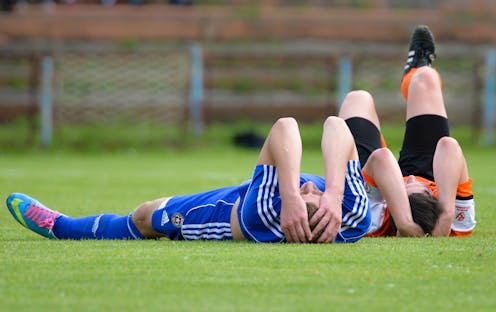A stronger neck can help young athletes reduce their risk of concussion
- Written by The Conversation

During Australia’s winter sports seasons, hundreds of thousands of children will take to the field in contact sports like rugby league, rugby union, Australian rules and soccer.
With this comes the ever-present risk of concussions, which can have serious short and long-term effects – especially for younger athletes.
While concussion protocols in professional sports are now common practice, with detailed return-to-play guidelines following head knocks, junior sports often lack comprehensive prevention strategies.
Despite growing awareness and rule changes aimed at increasing safety, concussion rates in junior sport remain concerning.
Despite growing awareness and rule changes in some sports, concussion is still a risk to many athletes.How bad is the problem?
Sports-related concussions account for a significant portion of emergency department visits and hospitalisations.
One in five concussion hospitalisations involve sport but this figure does not capture the full scope of concussions that are managed outside hospitals, such as those treated in general practice, by physiotherapists, or that go unreported.
The 2021–22 Australian Institute of Health and Welfare report on concussions in Australia over the past decade highlighted:
children and adolescents are particularly vulnerable. Boys aged 5–14 had the highest rates of emergency department presentations for concussions, suggesting sports and recreational activities play a significant role in injury occurrence at these ages.
young men are at highest risk of severe concussion requiring hospitalisation. Males aged 15–24 had nearly double the hospitalisation rate for concussion compared to females in the same age group.
although men had more concussions, when adjusted for participation numbers, women had higher concussion rates in contact sports such as rugby and Australian rules football. This means women proportionally experience concussions at a higher rate than men.
Read more: Should I get my child a baseline concussion test before they start junior sports?
Why children are more vulnerable to concussions
Children and adolescents are particularly susceptible to concussions as their brains are still developing. This makes them more vulnerable to the effects of head trauma.
Most young athletes also have significantly lower neck strength compared to adults. This weakness, combined with a proportionally larger head size relative to their neck, leads to greater forces transmitted to the brain when an impact occurs.
Youth athletes often also need longer recovery periods after concussions. Symptoms can affect their schoolwork, mental health and ability to return to sport.
While many sports have tried to lower concussion risks by implementing simplified gameplay and modifications to player-to-player contact, these approaches don’t directly boost an athlete’s physical capacity to withstand impacts.
Can neck strength reduce concussion risk?
One crucial yet often overlooked protective factor is neck strength.
Research suggests stronger necks can significantly reduce concussion risk by helping to stabilise the head during impact.
The reason appears obvious: a stronger neck helps stabilise the head during impact, reducing the acceleration forces transmitted to the brain.
Data from high school sports suggests athletes with stronger neck muscles can better control head movement during a collision. This essentially creates a more effective “shock absorber” system.
In soccer players, adolescents who performed neuromuscular neck exercises reported fewer concussions and possible concussive events. They also had less pain when heading the ball compared to those who didn’t perform the exercises.
A landmark study, which examined concussions in 6,662 high school athletes across multiple sports, discovered a direct relationship between neck strength and concussion risk. It found that if athletes developed stronger neck muscles, it reduced their risk of concussion.
This finding suggests even modest improvements in neck strength could yield significant protective benefits.
Why neck strength matters
Strengthening junior athletes’ necks extends beyond injury prevention.
Fewer concussions mean less time away from sport, potentially reducing dropout rates and encouraging long-term participation.
This has implications not just for athletic development but for public health more broadly, as lifelong sport participation contributes to better physical and mental wellbeing.
Cognitive protection is equally important.
By reducing concussion risk, we help safeguard young athletes’ academic performance and cognitive development.
For sporting organisations, implementing neck strength training represents a low-cost, effective intervention that demonstrates commitment to player welfare.
How to develop a stronger neck
Effective neck strengthening doesn’t require expensive equipment or extensive time commitments.
Simple exercises can be easily integrated into training sessions or warm-ups.
Isometric neck holds are a great starting point. Athletes place their hand against their forehead, temple, or the back of their head and push gently against resistance for 5–10 seconds. These exercises activate key neck muscles without requiring any equipment.
Over time, these exercises can be progressed using minimal equipment to increase the complexity and better mimic sports-specific movements.
The key is consistency. Performing these exercises two to four times weekly can produce meaningful improvements in neck strength and function.
An easy win
As the evidence mounts, one thing becomes increasingly clear: neck strength training represents a simple, effective strategy that may reduce the effects of concussion in junior athletes.
The minimal time and equipment requirements make it an accessible option in sports where head and neck injuries are a concern.
Parents, coaches and sporting bodies should consider making neck strengthening exercises a standard component of junior athlete training programs.
By doing so, we can help ensure our young athletes enjoy safer sporting experiences and healthier futures both on and off the field.







